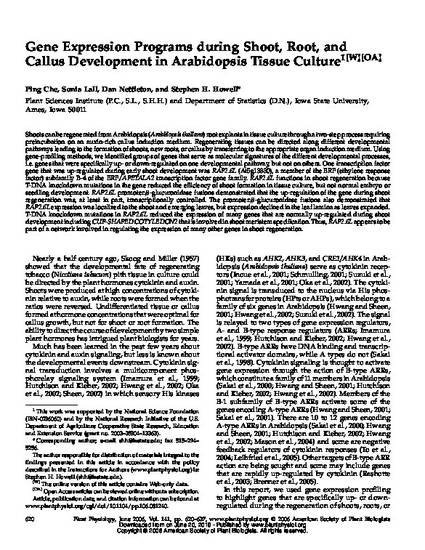
Shoots can be regenerated from Arabidopsis (Arabidopsis thaliana) root explants in tissue culture through a two-step process requiring preincubation on an auxin-rich callus induction medium. Regenerating tissues can be directed along different developmental pathways leading to the formation of shoots, new roots, or callus by transferring to the appropriate organ induction medium. Using gene-profiling methods, we identified groups of genes that serve as molecular signatures of the different developmental processes, i.e. genes that were specifically up- or down-regulated on one developmental pathway, but not on others. One transcription factor gene that was up-regulated during early shoot development was RAP2.6L (At5g13330), a member of the ERF (ethylene response factor) subfamily B-4 of the ERF/APETALA2 transcription factor gene family. RAP2.6Lfunctions in shoot regeneration because T-DNA knockdown mutations in the gene reduced the efficiency of shoot formation in tissue culture, but not normal embryo or seedling development. RAP2.6L promoter:β-glucuronidase fusions demonstrated that the up-regulation of the gene during shoot regeneration was, at least in part, transcriptionally controlled. The promoter:β-glucuronidase fusions also demonstrated that RAP2.6L expression was localized to the shoot and emerging leaves, but expression declined in the leaf lamina as leaves expanded. T-DNA knockdown mutations in RAP2.6L reduced the expression of many genes that are normally up-regulated during shoot development including CUP-SHAPED COTYLEDON2 that is involved in shoot meristem specification. Thus, RAP2.6L appears to be part of a network involved in regulating the expression of many other genes in shoot regeneration.
Available at: http://works.bepress.com/dan-nettleton/125/
